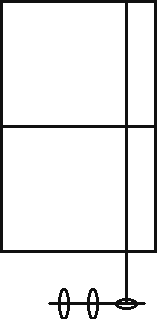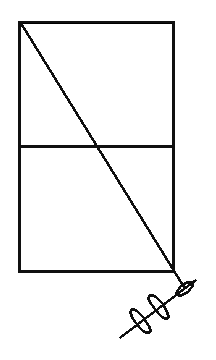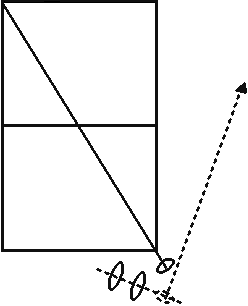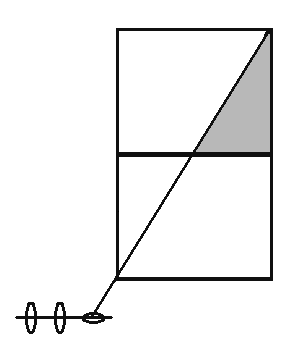|
|
||
|
|
||
|
|
FUNDAMENTAL TABLE TENNIS GEOMETRYAnyone who has watched Shaquille O'Neal shoot free throws should be convinced that fundamentals are important for players of all levels. Footwork is certainly one of the fundamentals of our sport, but instead of looking at how you should move your feet, I want to discuss something more basic: where you should put them. In baseball, everyone knows that the batter stands with his side facing the pitcher. However, in baseball, the batter holds the bat with both hands. In table tennis, we hold the racket with one hand, so where do our feet go? For definiteness, I'll assume you are right handed. Lefties, please excuse me and switch around what I say. Suppose you are warming up by hitting forehands with your practice partner. Stand facing the table. Draw a line though your hips and extend it to your right side. Hold your racket and place it at your side on the line through your hips. This is where you want to contact the ball. The ball will have to go in the direction the racket is facing, so draw a line perpendicular to your racket. This line is in the direction you are facing. Thus your feet should be facing in the same direction as you want to hit the ball and the line between your feet (or the line through your hips) should be perpendicular to the direction you are hitting. See Figure 1; the two vertical ellipses represent your feet and the horizontal ellipse represents your racket. Figure 1
Normally when warming up we hit corner to corner along the long diagonal. This gives us the longest length of table to work with and also gives us a point to aim at, e.g., the corner. (Always aim when you hit; don't hit all over the place.) But if we hit along the long diagonal and we want our feet to be facing the direction we are hitting, then we have to step in with our right foot. See Figure 2. Figure 2
I see so many players who have their right foot back when hitting forehands crosscourt. I always ask them if they are trying to hit crosscourt or are trying to hit the right wall (which is where they are facing). See Figure 3. Figure 3
In actuality, you probably won't be able to step in as much as the geometry suggests. The problem is that it is much easier to move sideways than backwards or forwards, so if you do step in that much, then it is too hard to adjust if your practice partner accidentally moves the ball around. But you still should be able to have your right foot a bit in front of your left foot when hitting crosscourt. Naturally, if you hit straight down the line, then you can have your feet next to each other (that is, the line through your feet can be parallel to the end line of the table) and you will be facing the direction you are hitting and you can easily move sideways to adjust to the ball. See Figure 1. A good exercise is to hit along the other diagonal. That is, hit forehands from your backhand corner to your practice partner's backhand corner. Now it should feel natural to have an open stance (i.e., the angle between the line between your feet and the direction the ball goes is greater than 90 degrees). See Figure 4. Hitting or looping with an open stance is often called hitting inside-out. People are often surprised when they see players do this (just listen to the tennis commentators on TV express their surprise), but it is really a more natural stroke. Figure 4
When hitting or looping we want to use all the muscles we can. In particular, we want to use our legs, hips, and shoulders. If you make a strong loop or a smash, then you can take a step forward with your right foot. In this case it is fine to start with your right foot back. Just make sure that you really step through. Otherwise you will find that you are contacting the ball in front of you and you can't stroke through the ball (or you are aiming at the right wall). If you've been hitting with a closed stance, give the open stance a try. At first it may feel funny, but if you get the hang of it, it will open up your game. Courtesy of David Marcus |
|
|
Last Update : 06 November, 2002 Copyright ┬ę 2001-2006 Ertan Patir Webmaster : |





